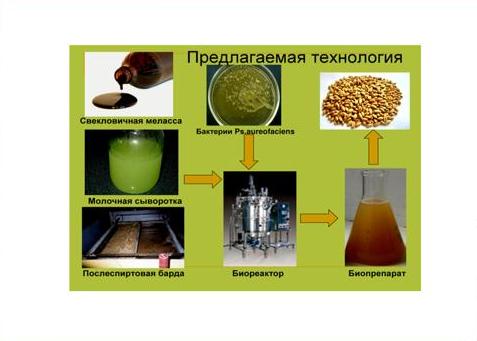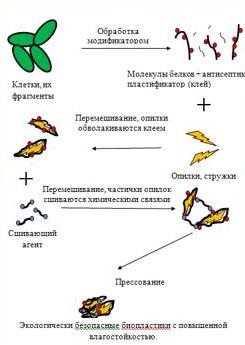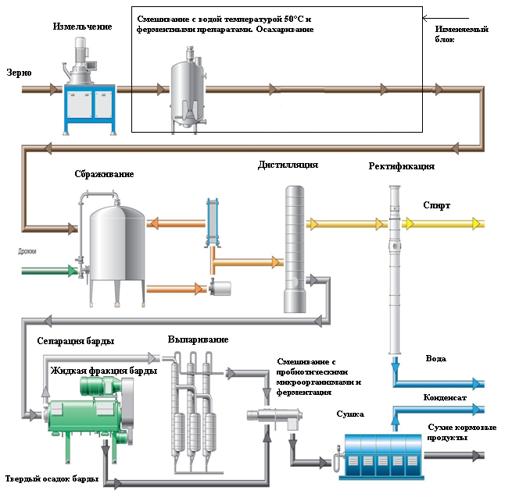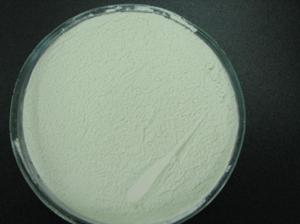BIODEGRADABLE MULTIPURPOSE PROTEIN-POLYSACCHARIDE MEMBRANES
The Chair of biotechnology, bioengineering and biochemistry carries out researches to obtain biopolymer protein-polysaccharide membranes linked with transglutaminase. This kind of membranes is homogeneous and their durability and tensility are comparable to those of polyethylene membranes, and they are capable of biodegradation in situ. Besides, they can be used as a substitute for synthetic polymers that are virtually non-degradable in situ.
Usage of polysaccharides, proteins and ferments of biological origin in composite compound allows to replace petrochemical materials that is now widely used for production of synthetic plastic materials, thus making possible the achievement of not only biodegradation, but also of durability of the membranes produced. Biostability and high ecological compatibility of the membranes is increased when using transglutaminase as one of the linking agents that is biologically active and is capable of proteins’ cross-linking.
Biodegradable membranes that are obtained that way contain proteins, gelatins or lactoprotein, as well as polysaccharides-alginate, chitosan or BC and have following characteristics: tensility (100-250%), durability (15-40 MPa), soil biodegradation (1-3 months).
Protein-polysaccharides based membranes and polymers that are linked with transglutaminase can be used in medicine, veterinary medicine, pharmaceutical, alimentary and cosmetic industry. Also, such membranes and polymers can be used in production of food wrap, capsules and packaging material.





Biodegradable protein-polysaccharide membranes linked with ferment

General arrangement for producing of the membranes
BIOTECHNOLOGY OF BIOETHANOL OBTAINED FROM ULTRADISPERSIVE PLANT RAW MATERIAL
The Chair is developing the technology of obtaining of burnable and alimentary bioethanol by deep mechano-biochemical processing of ultradispersive plan raw material followed by a leavenous bioconversion. Grain is used in the process of the development of the technology of obtaining of alimentary ethanol, and for burnable ethanol cellulose containing material is used with its particle of about 100-300 microns.
Morselized raw material undergoes fermentative hydrolysis by a complex of highly active ferments under mild conditions and is then attenuated by yeast. Technologies for attenuating of mesh standard and high density were also developed. Combination of methods of deep mechanical and biochemical processing eliminates one of the classic stages of ethanol production-cooking (when producing alimentary ethanol) or chemical hydrolysis (when producing burnable ethanol).
Procedure of obtaining of ethanol from jet-milled grain
Aforementioned technologies allow to reduce power consumption and capital investments while the alcohol output actually grows. All the researchers are carried out in cooperation with JSCo «Mordovspirt».
Followin patents have been granted:
1) Method of obtaining of alcohol / V.V. Revin, N.A. Atykyan, D.O. Zakharkin, invention patent RUS 2552165 06.08.2013
2) Method of obtaining of alcohol from lignocellulosic material / V.V. Revin, N.A. Atykyan, D.O. Zakharkin, invention patent RUS 2558303 07.10.2013
3) Method of obtaining of alcohol / N.A. Atykyan, V.V. Revin, invention patent RUS 2506312 16.04.2012
4) Method of obtaining of alcohol / V.V. Revin, N.A. Atykyan, invention patent RUS 2407798 22.04.2009
BIOTECHNOLOGY OF BIOPREPARATIONS FOR AGRICULTURE
The Chair of biotechnology, bioengineering and biochemistry is carring out researches to optimize the conditions of obtaining of biopreparations based off of bacteria Pseudomonas aureofaciens and Azotobacter Vinelandii to protect plants from blight caused by plant photogenic fungi that suppress the growth of cultivated plants and lead to the yield reducing.
It is widely known that the usage of chemical fungicides causes mass environment pollution and reduction of soil fertility. That’s exactly why the role of biological protection of plants in maintaining the safety of agricultural products and increasing of beneficial microflora is truly immense.
Thus far the staff of the Chair has been finishing the work on a process scheme of producing multifunctional biopreparation; its influence on germinative ability of Gramineae, Oleraceus and industrial cultures has been studied as well as lab tests have been carried out to find out the possible increased resistance of plants to phytopathogens and stress conditions. Moreover, the development of the technology of creation of the consortium of microorganisms that has a complex biological effect is in progress.


BIOTECHNOLOGY OF ADHESIVES OF BIOLOGICAL ORIGIN.
 During the last years natural adhesives have found extensive use. This is mostly due to the ecological problems and ways to solve them that are constantly found in highly developed countries. For example, merchandise that is packed in a synthetic glue-containing package is not imported in many European, Asian and American countries. That depends on an increased demand of customers that want any merchandise to be ecologically friendly.
During the last years natural adhesives have found extensive use. This is mostly due to the ecological problems and ways to solve them that are constantly found in highly developed countries. For example, merchandise that is packed in a synthetic glue-containing package is not imported in many European, Asian and American countries. That depends on an increased demand of customers that want any merchandise to be ecologically friendly.
The main component of adhesive is a glue matter that provides adhesional and cohesive durability. Biopolymers such as collagen, casein, amylopectin, dextrin and etc. are a basis of natural adhesives and usually are quite expensive. Microbic polysaccharides and proteins can be a substitute for them and can be obtained from food waste that contains nutritional ingredients that are necessary for this task, for example: molasses, milk whey, butter milk, brewery and alcohol waste.
Constant search for new and cheaper sources of adhesives is crucial. Waste and recyclable materials from microbiotic fabrication contain a lot of biopolymers. For many years the Chair has studied ways to obtain various adhesives that partly consist of food and pharmaceutical industies’ waste; modification of the main components of adhesives; modification products are also studied i.e. their adhesive capacity, various additives (obtained from different sources of waste material) and their influence on the adhesive capacity of bioadhesives are tested. One of such ways consists in dextran synthesis by using Leuconostoc mesenteroides in cheap nutrient mediums that contain sugar, dairy and alcohol industries’ waste. While microbes grow they form a great amount of highly polymeric compounds such as polysaccharides that have some valuable adhesive features. They can be used as a main component of bioglues and also as an adhesive for ecologically friendly biocomposite materials. Those polysaccharides are completely harmless and are used even in medical practice. This is why glue compounds that have them as a basis can be used in food industry for applying labels and producing of paper containers.

The staff of the Chair has optimized the composition of nutrient mediums containing molasses, butter-milk, milk whey and grain stillage as well as the conditions of fermentation that provide the maximum output of industrial dextran.
Levan is another promising biopolymer and is produced by a wide range of microorganisms, specifically by Azotobacter. This polysaccharide is formed with the residue of fructose (D-fructofuranose connected by β–2 → 6 and by α–2 → 1 connections in branching points) that is packed in compact spherical structures. Unlike the majority of other polysaccharides, levan isn’t water-swellable and is capable of forming crystals. Levan has outstanding adhesion properties due to the large amount of hydroxyl groups that help to form glue bonds with different substrates. It is absolutely harmless for people and ecologically friendly. Bioadhesives based on bacterial polysaccharides can be used to produce corrugated board or to obtain composite materials from lignocellulosic raw materials.
Process scheme for obtaining of wood laminate by using bioadhesive containing microbal polysaccharides

Process scheme for obtaining of moulded composite materials by using of bioadhesives obtained from organic waste material.

Process scheme for obtaining of water proof composite materials from yeast waste
BIOTECHNOLOGY OF MICROBIC POLYSACCHARIDES
The Chair of biotechnology, bioengineering and biochemistry has conducted researches and studied xanthan, dextran, alginate, levan and bacterial cellulose.
Bacterial cellulose is a promising material for obtaining a wide variety of products and nanomaterials. Its potential as a biomaterial for medical industry and for tissue engineering in particular is great, it can be used to create wound coverings and transdermal therapeutic systems. It can also be used in dietology as a supplements carrier for a balanced diet, or in industrial electronics for obtaining of optically-transparent compounds with an extremely low temperature expansion coefficient, or acoustic diaphragms; it can also be a substitute for vegetable cellulose in paper manufacturing. Bacterial cellulose is a promising source of nanocrystal cellulose and biocomposite materials.
The Chair has obtained a new producer of bacterial cellulose-Gluconacetobacter sucrofermentans B-11267 (patent RU 2523606). The technology for obtaining of bacterial cellulose from industry waste (patents RU 2536973, 2536257) was developed. The samples of bacterial cellulose were tested and the biocomposites based on them were successfully obtained (patent RU 2564567).
Xantan is a biopolymer of microbic origin which is widely used in food, petroleum, pharmaceutical, mining, textile and coating industry. Xantan is ecologically friendly , non-toxic (used in food industry as a stabilizer and a thickener E 415), it doesn’t affect the processes of oil extraction and processing and it is permitted to use at Russian oil-extracting enterprises.
Some highly-productive strains of Xanthomonas campestris were obtained as a result of selection, they produce up to 26 grams of xantan per liter. Two certificates of strains’ deposit have been received. The Chair has studied morphological and physiological-chemical properties of bacteria and has optimized the conditions of their storage. The technical specification for xantan’s production was developed. To lower costs of production it is recommended to use media that contain waste from various biotechnological manufactures. Tests of polysaccharide on linear models of formations have shown that the preparation obtained had filtration and oil-sweeping properties of the same level as of the French-produced polysaccharide Rodopol-23P. Xantan’s production in Russia will allow ceasing the importation of it from abroad.
Gel-membrane of bacterial cellulose Xantan powder
Process scheme for xantan production
BIOTECHOLOGY OF NANOCOMPOSITE MATERIALS BASED ON NANOCRYSTAL CELLULOSE
The Chair of biotechnology, bioengineering and biochemistry is carrying out allocation of nanocrystal cellulose from bacterial cellulose.
Cellulose is one of the most widespread polymers naturally. For a long time vegetable cellulose has been used in paper production mostly. Cellulose’s fibril contains sections with crystal and amorphous structure. Crystal part of cellulose is very durable and can be compared with the durability of high tensile steel or of Kevlar thus making it possible to use nanocrystal cellulose as a nanosized improver to increase mechanical properties of composite material or on its own as a separate material.
At the present day carbon nanotubes, graphitized nanofibers, nanotubes with grafted layers and functional groups are used as a nanosized filler in the process of development of composite material.
As an alternative to nanotubes nanocrystal cellulose can be used, it is obtained from variable renewable sources such as wood, plant raw material or bacterial cellulose. Having such a variety of raw material like this makes producing of nanocrystal cellulose economically more profitable than producing of nanotubes, and high mechanical properties of nanocrystal cellulose maske it possible to say that it is a prefect material for increasing of the mechanical properties of nanocomposite materials.
Using of bacterial cellulose with long fibrils and a high degree of crystallinity allows obtaining of nanocrystal cellulose with a higher correlation between nanocrystal’s length and width. It is believed that increased length of nanocrystal cellulose makes it more durable.
Nanocrystal cellulose is used as nanosized additive for increasing of strength properties of nanocomposite material obtained from polyvinyl alcohol that is used in production of aerogel. Aerogel’s low thermal conductivity and density makes it an outstanding heat-sealing material and due to its high-surface area it can be also used as an adsorbing material in water and air purification from organic and non-organic pollution agents.
STUDYING OF MOLECULAR AND CELLULAR MECHANISMS OF EXCITATION, DEGENARATION AND REGENERATION OF EXCITABLE FORMATIONS.
The Chair of biotechnology, bioengineering and biochemistry has been carrying out the researches of influence of biologically active compounds on the structure, protein-lipidic composition and the functioning of a damaged peripheral nerve.
The role of meylin sheath of the nerve and its neuroglia in degenerative and regenerative processes is also studied.
The stimulatory effect of xymedon, laminin, hyaluronic acid and resveratrol on the processes of regeneration has been studied as well as their normalizing effect on the composition of lipids and proteins, protein-lipidic interaction and lipid peroxygenation in damaged peripheral nerves.
STUDYING OF MECHANISMS OF THE ERYTHROCYTES OXYGEN-TRANSPORTING FUNCTION’S REGULATION
The Chair uses a wide variety of physical and physico-chemical methods to study the mechanisms of regulations of oxygen-binding and oxygen-transporting functions of erythrocytes thus trying to find new natural compounds of flavonoid origin to improve the transporting function of hemoglobin; the mechanisms of cellular death are also studied according to the RSF research project №15-15-10025.
It was found out that peripheral vascular diseases alongside classic mechanisms of progression are often accompanied by pathological changes in erythrocytes such as structural and physiological reconstruction of hemoglobin.
New information on the erythrocyte’s denucleation and structural-functional state of membrane after apoptosis induction was obtained. The Chair was the first to study the ejection of pigeon’s erythrocytes nuclei followed by disintegration of cells to apoptotic vesicles. Fatty acid composition of several lipidic fractions under the influence of hydrogen peroxide and UV irradiation has been studied. The induction of apoptosis by sphingomyelin, phosphatidyserinem, diacyglycerol and oleic acid. The connection between erythrocytes apoptosis and the changing of membranes lipidic components was found.
a b
c d
Representation of human erythrocytes obtained via CR-spectroscopy
a-healthy person; b, c-blood vessel disease patients; d-patients after treatment



















